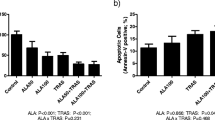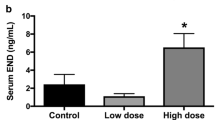Abstract
Background
Data derived from epidemiological and experimental studies suggest that alphalinolenic acid (ALA; 18:3n-3), the main ϖ-3 polyunsaturated fatty acid (PUFA) present in the Western diet, may have protective effects in breast cancer risk and metastatic progression. A recent pilot clinical trial assessing the effects of ALA-rich dietary flaxseed on tumor biological markers in postmenopausal patients with primary breast cancer demonstrated significant reductions in tumor growth and in HER2 (erbB-2) oncogene expression.
Hypothesis
The molecular mechanism by which ALA inhibits breast cancer cell growth and metastasis formation may involve a direct regulation of HER2, a well-characterized oncogene playing a key role in the etiology, progression and response to some chemo- and endocrine therapies in approximately 20% of breast carcinomas.
Methods
Using HER2-specific ELISA, flow cytometry, immunofluorescence microscopy, Western blotting, RT-PCR and HER2 promoter-reporter analyses, we characterized the effects of exogenous supplementation with ALA on the expression of HER2 oncogene, a master key player in the onset and metastasis formation of breast cancer disease. Metabolic status (MTT) assays were performed to evaluate the nature of the cytotoxic interaction between ALA and the humanized anti-HER2 monoclonal antibody trastuzumab (Herceptin®). To study these issues we used BT-474 and SKBr-3 breast cancer cells, which naturally exhibit amplification of the HER2 oncogene.
Results
ALA treatment dramatically suppressed the expression of HER2-coded p185Her-2/neu oncoprotein as determined by ELISA, flow cytometry, immunofluorescence microscopy and immunoblotting techniques. Interestingly, ALA-induced down-regulation of p185Her-2/neu correlated with a transciptional response as no HER2 mRNA signal could be detected by RT-PCR upon treatment with optimal concentrations of ALA (up to 20 μM). Consistent with these findings, ALA exposure was found to dramatically repress the activity of a Luciferase reporter gene driven by the HER2 promoter. Moreover, the nature of the cytotoxic interaction between ALA and trastuzumab (Herceptin®) revealed a significant synergism as assessed by MTT-based cell viability assays.
Conclusions
i) These findigns reveal that the ω-3 PUFA ALA suppresses overexpression of HER2 oncogene at the transcriptional level, which, in turn, interacts synergistically with anti-HER2 trastuzumab-based immunotherapy.ii) Our results molecularly support a recent randomized double-blind placebo-controlled clinical trial suggesting that ALA may be a potential dietary alternative or adjunct to currently used drugs in the management of HER2-positive breast carcinomas.iii) Considering our previous findings demonstrating the «HER2 upregulatory actions» of the ω-6 PUFA linolenic acid (LA; 18:2n-6) and the «HER2 down-regulatory actions» of the ω-3 PUFA docosahexaenoic acid (DHA; 22:6n-3) and of the ω-9 monounsaturated fatty acid oleic acid (OA; 18:1n-9), it is reasonable to suggest that a low ω-6/ω-3 PUFA ratio and elevated MUFA levels, the two prominent «fat features» of the «Mediterranean diet», should be extremely efficient at blocking HER2 expression in breast cancer cells.
Similar content being viewed by others
References
Bougnoux P, Koscielny S, Chajes V, Descamps P, Couet C, Calais G. Alphalinolenic acid content of adipose tissue: a host determinant of the risk of early metastasis in breast cancer. Br J Cancer. 1994;70:330–4.
Klein V, Chajes V, Germain E, et al. Low alpha-linolenic acid content of adipose tissue is associated with an increased risk of breast cancer. Eur J Cancer. 2000;56: 555–40.
Kamano K, Okuyama H, Konishi R, Nagasawa H. Effects of a high-linoleate and high-alpha-linolenate on spontaneous mammary tumorigenesis in mice. Anti-cancer Res. 1989;9:1903–8.
Fritsche KL, Johnston PV. Effect of dietary alpha-linolenic acid on growth, metastasis, fatty acid profile and prostaglandin production of two murine mammary adenocarcinomas. J Nutr. 1999;120:1601–9.
Hirose M, Masuda A, Ito N, Kamano K, Okuyama H. Effects of dietary perilla oil, soybean oil and safflower oil on 7,12-dimethylbenz(a) anthracene (DMBA) and 1,2-domethylhydrazine (DMH)-induced mammary gland and colon carcinogenesis in female SD rats. Carcinogenesis. 1990; 11:731–5.
Munoz SF, Silva RA, Lamarque A, Guzmán CA, Eynard AR. Protective capability of dietary Zizyphus mistol seed oil, rich in 18/3 n−3, on the development of two murine mammary gland adenocarcinomas with high and low metastatic potential. Prostaglandins Leukot Essent Fatty Acids. 1995;53:135–8.
Chajes V, Sattler W, Stranzl A, Kostner GM. Influence of n−3 fatty acids on the growth of human breast cancer cellsin vitro: relationship to peroxides and vitamin E. Breast Cancer Res Treat. 1995; 34:199–212.
Thompson LU, Chen JM, Strasser-Weippl K, Goss PE. Dietary flaxseed alters tumor biological markers in postmenopausal breast cancer. Clin Cancer Res. 2005;11: 3828–35.
Yamamoto T, Ikawa S, Akiyama T, et al. Similarity of protein encoded by the human c-erbB-2 gene to epidermal growth factor receptor. Nature. 1986;319:230–4.
Bargmann CI, Hung MC, Weinberg RA. The neu oncogene encodes an epidermal growth factor receptor-related protein. Nature. 1986;319:226–30.
Slamon DJ, Clark GM, Wong SG, Levin WJ, Ullrich A, McGuire WL. Human breast cancer: correlation of relapse and survival with amplification of the HER-2/neu oncogene. Science. 1987;235:177–82.
Slamon DJ, Godolphin W, Jones LA, et al. Studies of the HER-2/neu proto-oncogene in human breast and ovarian cancer. Science. 1989;244:707–12.
Ross JS, Fletcher JA. The HER-2/neu oncogene in breast cancer: prognostic factor, predictive factor, and target for therapy. Stem Cells. 1998;16:413–28.
Di Fiore PP, Pierce JH, Kraus MH, et al.erbB-2 is a potent oncogene when overexpressed in NIH/3T3 cells. Science. 1987; 237:178–82.
Hudziak RN, Schlessinger J, Ullrich A. Increased expression of the putative growth factor receptor p185HER2 causes transformation and tumorigenesis of NIH 3T3 cells. Proc Natl Acad Sci USA. 1987;84: 7159–63.
Xu R, Perle MA, Inghirami G, Chan W, Delgado Y, Feiner H. Amplification of Her-2/neu gene in Her-2/neu-overexpressing and-nonexpressing breast carcinomas and their synchronous benign, premalignant, and metastatic lesions detected by FISH in archival material. Mod Pathol. 2002;15:116–24.
Hoque A, Sneige N, Sahin AA, Menter DG, Bacus JW, Hortobagyi GN, et al. Her2/neu gene amplification in ductal carcinomain situ of the breast. Cancer Epidemiol Biomarkers Prev. 2002;11:587–90.
Tan M, Yao J, Yu D. Overepression of the c-erbB-2 gene enhanced intrinsic metastasis potencial in human breast cancer cells without increasing their transformation abilities. Cancer Res. 1997;57:1199–205.
Eccles SA. The role of c-erbB-2/HER2/neu in breast cancer progression and metastasis. J Mammary Gland Biol Neoplasia, 2001;6:393–406.
Yakes FM, Chinratanalab W, Ritter CA, et al. Herceptin-induced inhibition of phosphatidylinositol-3 kinase and Akt is required for antibody-mediated effects on p27, cyclin D1, and antitumor action. Cancer Res. 2002;62:4152–41.
Kraus MH, Popescu NC, Amsbaugh SC, et al. Overexpression of the EGF receptor-related proto-oncogeneerbB-2 in human mammary tumour cell lines by different molecular mechanisms. EMBO J. 1987;6:605–10.
Bates NP, Hurst HC. Transcriptional regulation of type 1 receptor tyrosine kinases in the mammary gland. J Mammary Gland Biol Neoplasia. 1997;2:153–63.
Hurst HC. Update on HER-2 as a target for cancer therapy. TheerbB-2 promoter and its exploitation for cancer treatment. Breast Cancer Res. 2001;3:395–8.
Carter P, Presta L, Gorman CM, et al. Humanization of an anti-p185HER2 antibody for human cancer therapy. Proc Natl Acad Sci USA. 1992;89:4285–9.
Baselga J, Tripathy D, Mendelsohn J, et al. Phase II study of weekly intravenous recombinant humanized anti-p185HER2 monoclonal antibody in patients with HER2/neu-overexpressing metastatic breast cancer. J Clin Oncol. 1996;14:737–44.
Cobleigh MA, Vogel CL, Tripathy D, et al. Multinational study of the efficacy and safety of humanized anti-HER2 monoclonal antibody in women who have HER2-overexpressing metastatic breast cancer that has progressed after chemotherapy for metastatic disease. J Clin Oncol. 1999;17:2639–48.
Vogel CL, Cobleigh MA, Tripathy D, et al. Efficacy and safety of trastuzumab as a single agent in first-line treatment of HER2-overexpressing metastatic breast cancer. J Clin Oncol. 2002;20:719–26.
Slamon DJ, Leyland-Jones B, Shak S, et al. Use of chemotherapy plus a monoclonal antibody against HER2 for metastatic breast cancer that overexpress HER2. N Engl J Med 2001;544:785–92.
Ross JS, Fletcher JA, Bloom KJ, et al. Targeted therapy in breast cancer: the HER-2/neu gene and protein. Mol Cell Proteomics. 2004;3:379–98.
Nahta R, Yu D, Hung MC, Hortobagyi GN, Esteva FJ. Mechanisms of Disease: understanding resistance to HER2-targeted therapy in human breast cancer. Nat Clin Pract Oncol. 2006;3:269–80.
Wahle KW, Rotondo D, Heys SD. Polyunsaturated fatty acids and gene expression in mammalian systems. Proc Nutr So. 2003;62:349–60.
Jump DB. Fatty acid regulation of gene transcription. Crit Rev Clin Lab Sci. 2004; 41:41–78.
Pégorier JP, Le May C, Girard J. Control of gene expression by fatty acids. J Nutr. 2004;154:2444S-9S.
Menendez JA, Ropero S, Lupu R, Colomer R. Dietary fatty acids regulate the activation status of Her-2/neu (c-erbB-2) oncogene in breast cancer cells. Ann Oncol. 2004;15:1719–21.
Menéndez JA, Lupu R, Colomer R. Exogenous supplementation with omega-3 polyunsaturated fatty acid docosahexaenoic acid (DHA; 22∶6n−3) synergistically enhances taxanes cytotoxicity and downregulates Her-2/neu (c-erbB-2) oncogene expression in human breast cancer cells. Eur J Cancer Prev. 2005;14:263–70.
Menéndez JA, Vellón L, Colomer R, Lupu R. Oleic acid, the main monounsaturated fatty acid of olive oil, suppresses Her-2/neu (erbB-2) expression and synergistically enhances the growth inhibitory effects of trastuzumab (Herceptin) in breast cancer cells with Her-2/neu oncogene amplification. Ann Oncol. 2005;16:359–71.
Menéndez JA, Vellón L, Colomer R, Lupu R. Effect of gamma-linolenic acid on the transcriptional activity of the Her-2/neu (erbB-2) oncogene. J Natl Cancer Inst. 2005;97:1611–5.
Menéndez JA, Papadimitropoulou A, Vellón L, Colomer R, Lupu R. A genomic explanation connecting “Mediterranean diet”, olive oil and cancer: Oleic acid, the main monounsaturated fatty acid of olive oil, induces formation of inhibitory “PEA3 transcription factor-PEA 3 DNA binding site” complexes at the Her-2/neu (erbB-2) oncogene promoter in breast, ovarian and stomach cancer cells. Eur J Cancer. 2006 Jan 4 [Epub ahead of print].
Menéndez JA, Lupu R. RESPONSE: Re: Effect of-Linolenic Acid on the Transcriptional Activity of the Her-2/neu (erbB-2) Oncogene. J Natl Cancer Inst. 2006;98:718–20.
Bougnoux P, Giraudeau B, Couet C. Diet, cancer and the lipidome. Cancer Epidemiol Biomarkers Prev. 2006;15:416–21.
Author information
Authors and Affiliations
Corresponding authors
Additional information
This work was supported in part by the Instituto de Salud Carlos III (Ministerio de Sanidad y Consumo, Fondo de Investigación Sanitaria), Spain (Grant CP05-00090) to JAM and by the NIH grant awarded to RL (Grant 5R01CA116623).
Rights and permissions
About this article
Cite this article
Menéndez, J.A., Vázquez-Martín, A., Ropero, S. et al. HER2 (erbB-2)-targeted effects of the ϖ-3 polyunsaturated. Fatty acid α-linolenic acid (ALA; 18:3n-3) in breast cancer cells: the «fat features» of the «Mediterranean diet» as an «anti-HER2 cocktail». Clin Transl Oncol 8, 812–820 (2006). https://doi.org/10.1007/s12094-006-0137-2
Received:
Accepted:
Issue Date:
DOI: https://doi.org/10.1007/s12094-006-0137-2




